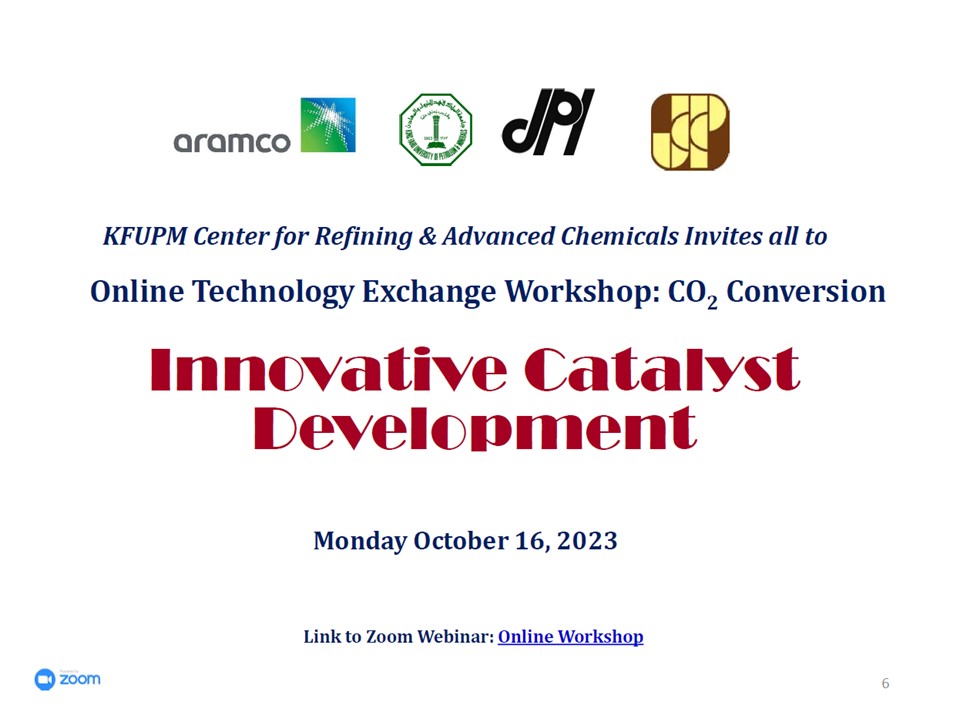Online Technology Exchange Workshop: CO2 Conversion
Organized by: IRC-RAC
Abstract 1
Presenter: Prof. Noritatsu Tsubaki, Graduate School of Engineering and Sustainable Technology Center, University of Toyama, Japan
Title: CO2-To-PX: New Frontier of CO2 Chemistry
Conversion of CO2 to valued chemicals is a key technology to realize the carbon-neutral society. We invented the one-step synthesis of para-xylene (PX) from CO2 hydrogenation (1, 2), for the first time in the world, based on the “capsule catalyst” concept (3) innovated by us, by accomplishing six-step classic synthesis reactions into one-step synthesis, realizing real negative-carbon technology.
By combining methanol synthesis or Fischer-Tropsch synthesis with molecule-shape selectivity of in situ zeolite membrane catalyst, PX can be selectively synthesized, suppressing the formation of other undesired aromatic by-products (4).
PX is easily oxidized to form the T of PET which is produced 50MT/Y worldwide from crude now. If all PX is from CO2, we can cut CO2 of 160MT/Y, equal to one-tenth of Japan annual CO2 emission. Being scaled up now with five Japanese companies with the aid of Japanese government, we hope to launch the commercialized zero-carbon PX plant in 2028.
Ref.
(1) Chemical Science (cover paper), Vol. 8, 7941-7946, 2017 (PCT 2017)
(2) ACS Catalysis, Vol. 9, 895-901, 2019 (PCT 2018)
(3) Angewandte Chemie International Edition, Vol. 47, 353-356, 2008
(4) Applied Catalysis B: Environmental, Vol. 303, 120906, 2022
Abstract 2
Presenter: Dr. Aniz C Ummer, Interdisciplinary Research Center for Refining & Advanced Chemicals, KFUPM
Title: “CO2 Hydrogenation to value added chemicals; A dual benefit approach”
Introduction: Greenhouse gases such as carbon dioxide (CO2), methane (CH4), nitrous oxide (N2O) and fluorinated gases are being emitted to the atmosphere and it become a major concern for industries across the globe. Conversion of CO2 to useful chemicals can reduce their release to atmosphere and simultaneously result in economic benefits as well. The process of hydrogenation of CO2 to hydrocarbons, syngas, oxygenates and aromatics has got huge response from the scientific community as these molecules are important raw materials for plastics and polymers, fine chemicals and petrochemicals. Large number of studies are reported on developing and effective utilization of different materials as catalysts, viz. CO2 valorization 1, ketonization 2, adsorption 3. CO2 hydrogenation 4 is also reported to an effective process to convert CO2 into hydrocarbons.
Experimental/methodology: In this work, metal oxide based by product material, namely red mud and its modified versions are utilized as catalysts (containing Fe & Al oxides in major). These mixed metal oxides mixed with zeolites to get hybrid dual function catalysts. They were characterized using X-ray diffraction (XRD), temperature program reduction using H2 (H2-TPR) and N2 adsorption/desorption method etc. All the prepared samples were tested and their performance for CO2 hydrogenation application was demonstrated using a fixed bed test reactor at 350C and 40 bar pressure in down-flow mode using the feed containing CO2 and H2 at 1:3 ratio. Attempts have been done to understand the chemistry and mechanism of the reaction after carefully interpreting the characterization results
Results and discussion: Red Mud based catalyst showed CO2 conversion between 10 to 15%. CO is a significant product in all cases, whereas methane is produced in considerable amounts over all the samples. Zeolite modification showed significant improvement in olefin formation owing to improved acidity that may enhance the CO2 adsorption
Abstract 3
Presenter: Dr. Saheed Ganiyu, Associate Professor, Chemistry Department, KFUPM
Title: “Selectivity of bimetallic unsupported catalysts towards olefins production via CO2- hydrogenation reaction ”
CO2 is a major contributor in greenhouse emission, due to its abundance discharge into the environment through different anthropogenic sources. Thus, it is imperative to capture and utilize CO2 for economic and environmental benefits through energy generation and valuable chemical production. CO2 can be valorized in different ways into potentially valuable products such as CO, , methane, methanol, DME, ethylene etc. and other intermediates through various reactions. Hydrogenation of CO2 into valuable compounds is a possible path for improved carbon utilization to offset environmental deterioration caused by the greenhouse effect and to produce industrial building-block chemicals, such as light olefins, methanol and DME.
This study explores the intrinsic features of unsupported bimetallic catalysts for production CO, DME and ethylene. The selectivity of the C2-ethylene improves as a function of tuning the active centers in bimetallic compositional ratio. The structure-activity were correlated by using various spectroscopy, microscopy, temperature-programmed and sorption techniques. These catalysts showed CO2-conversion of more than 25%, with diverse selectivity into CO, DME and ethylene. The current research holds a great potential for emission reduction, and a path to net zero emission.
